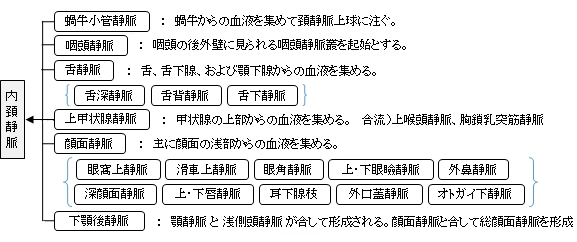
・ 舌動脈の伴行静脈となるが、舌動脈が舌骨舌筋の内側を通過するのに対して、舌静脈はその外側を通過する。



以下は「 日本人体解剖学 」の解説文となる。
「 舌の静脈を集め、顎下腺および舌下腺からの静脈も受ける。舌静脈には舌深静脈、舌背静脈、舌下静脈の3根がある。舌下静脈には、舌下神経伴行静脈が注ぐ。 」
また、「 船戸和弥のHP 」では以下のように解説している。
「 舌静脈は舌からの舌深静脈と舌背静脈、ならびに顎下腺、舌下腺からの舌下静脈が合して形成される。舌下静脈は舌下神経伴行静脈をも受ける。舌骨舌筋に対して舌動脈は内側を通るのに対して、舌静脈はその外側を通過する。内頚静脈または顔面静脈へ注ぐ。」
「 船戸和弥のHP 」では内頚静脈に合流する静脈として以下の6つの静脈を挙げている。


以下は「 Wikipedia 」の解説文となる。
「 The lingual veins begin on the dorsum, sides, and under surface of the tongue, and, passing backward along the course of the lingual artery, end in the internal jugular vein.
The vena comitans of the hypoglossal nerve ( ranine vein ) , a branch of considerable size, begins below the tip of the tongue, and may join the lingual; generally, however, it passes backward on the hyoglossus, and joins the common facial.
The lingual veins are important clinically as they are capable of rapid absorption of drugs ; for this reason, nitroglycerin is given under the tongue to patients suspected of having angina pectoris.
【 語 句 】
・ internal jugular vein : 内頚静脈 ・ vena comitans of the hypoglossal nerve : 舌下神経伴行静脈 ・ hyoglossus : 舌骨舌筋 ・ clinically : 臨床的に ・ nitroglycerin : ニトログリセリン ・ angina pectoris : 狭心症
【 イラスト掲載サイト 】
・ イラストや写真を掲載しているサイト-Ⅰ
・ イラストや写真を掲載しているサイト-Ⅱ
・ イラストや写真を掲載しているサイト-Ⅲ

|